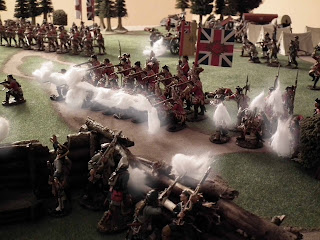In
preparation for a new chapter in our French Indian War narrative campaign we
have a small scale skirmish planned using the Muskets and Tomahawks rules from Studio Tomahawk.
We plan to
recreate a Rangers Raid on an Indian village in the Ohio Valley to recapture
the daughters of the British Officer. The last attempt to secure the prisoners
by force met with failure as the British line fell to pieces in the depth of
the woods. The British have decided to fight fire with fire.
As there is
only a limited number of John Jenkins Design Woodland Indian sets currently available, some of which are out
of production we did consider we might not have enough Indians to fully realise
our vision.
Having picked
up a few individual figures, I also acquired some complete boxed sets at a
later date and was left with some duplicates which seemed suitable for
re-painting.
It might seem
a shame to re-paint such superbly finished hand painted collector’s models but having seen other people's conversions it seemed it worth a try.
I selected
figures from WIM-04 Woodland Indians with Muskets #3 and the WIM-07 Woodland Indians Attacking, as these were the ones I had duplicates of.
Rather than
re-paint the entire model, I chose to touch up a few specific areas that I felt
would help the model look different from its ‘clone’.
The kneeling
Indian with rifle from WIM-04 set is a quite distinctive figure with its full
black body paint, so this was an obvious choice to re-colour without the
war-paint.
 |
| WIM-04 - Original on left, re-paint on right. |
The Indians
from the WIM-07 set have distinctive war-paint, buckskin trousers and loin
cloths, so whilst other alterations were made, these were the areas I focused on.
 |
| WIM-07 - Original on left, re-paint on right. |
The first
step was to gently clean the figures in warm soapy water. Some of the figures
have gathered dust so I used a soft brush to clean the parts we couldn't reach.
The figures
were set aside and once dry, painting could begin.
A wide
selection of acrylic paints was used from the likes of Humbrol, Vallejo, Games
Workshop and Tamiya.
The painting
style is a little different to my personal technique and took a little getting
used to but progress was quite quick. The figures were finished with a light
coat of matt spray varnish.
I am happy with the overall effect and look forward to using the figures in our next game.
 |
| WIM-07 - Original on right, re-paint on left. |
I am happy with the overall effect and look forward to using the figures in our next game.





















